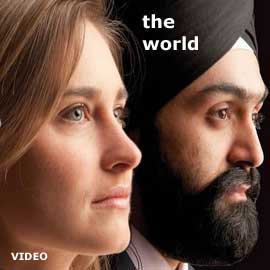Partition
The Gurdwaras & Sikh School of Haripur
Tales of Haripur - Part VI
by Dr. Bhai HARBANS LAL
There were five gurdwaras in Haripur town. One must not forget that every village and every small town in the vicinity and surrounding areas of Haripur also had a neighborhood gurdwara.
Gurdwara Guru Nanak Satsang Sabha was the oldest one. I went mostly to this gurdwara every day as it was nearest to my home. My daily routine, and routine of many others, was to start the day with a visit to the gurdwara for sangat and thereafter to school.
Besides local raagis and kathakars, many groups from outside would also visit Haripur, stay for a couple of weeks or so for sharing and disseminating their thoughts and elements of faith. I recall listening to famous raagi jathas such as Bhai Santa Singh, Bhai Avtar Singh, Bhai Sarab Singh, and a host of others.
I vividly recall that once I was immensely moved and enthralled by the highly melodious and riveting kirtan of one such raagi named Bhai Sarab Singh. I wanted to offer some money but I was then only 6-7 years old and did not possess any cash. Nevertheless, I pledged in silence to myself that when I grow up and have enough money of my own, I will donate some to him.
It so happened that when I was in college after the Partition, I had to visit Patiala for a conference. I unexpectedly came across Bhai Sarab Singh running his dental practice. I ran into his clinic with tears in my eyes. I told him of my pledge several years earlier and offered a small amount of money as I was still a student, living within a limited small budget. He got up and embraced me to show his affection to me but did not accept the money. He invited me to his kirtan in a Patiala gurdwara. He
asked me to do katha of gurbani which I gladly accepted to do. The congregation appreciated and honored me with the traditional siropa.
The Guru Nanak Santsang Sabha Gurdwara ran a library for the town of Haripur under the name of ‘Guru Nanak Library.’ I had the honor of serving as its secretary for several years. I remember routinely getting the newspapers and periodicals such as Partap, Ajit, and Milap all published in the Urdu language. Akali Patrika and the Khalsa Samachar were Punjabi newspapers while Liberator Weekly was the English paper edited by well-known Sikh scholar, Dr. Gopal Singh.
Gurdwara Singh Sabha was located at a long distance from our home. As such we would go there once in a while. This gurdwara was considerably active. It was built in the center of a residential area and therefore was well protected from the attacks which were to come later, unlike the Guru Nanak Sat Sang Sabha. Thus, when Haripur was attacked from the surrounding villages during the communal riots, the Satsang Sabha was pelted with stones and set on fire because of its location on the main road where it was fully exposed to such attacks. The Singh Sabha, on the other hand, was saved due to the limited access to it.
Then there was a small neighborhood gurdwara without any specific name. Along with some other youth, I used to visit there for a weekly class on Sikh music. It is also there that I learnt Gurmukhi and to read the Guru Granth Sahib.
Haripur also had a gurdwara exclusively for women. Although many women would also attend other gurdwaras, yet some of them would go only to this gurdwara. The underlying reason for going to this gurdwara was the overall local culture that discouraged the exposure of women to male strangers.
This gurdwara had the singular privilege of having two woman clergy, Bhen Narain ji and Bhen Dhanwanti ji. Until the time of Partition, this gurdwara - located in the North West Frontier Province, a few miles from Islamabad and Gurdwara Punja Sahib - was a vibrant place for Sikh services, and was, above all, managed only by woman granthis.
The Istari SatSang Sabha, as this gurdwara was named, was where my mother, Ramkali Devi, paid daily visits to learn and practice gurmat and Sikhi. When all efforts of my parents to conceive a child had failed, my mother turned in desperation to Bhen Narain ji and Bhen Dhanwanti ji for spiritual guidance.
My parents were given counsel by these two angels who, in their wisdom, came up with an unusual proposal: adopt a child from the family of Guru Nanak!
My parents accepted the proposal, which in turn thrilled them with renewed hope. They decided to immediately proceed with the idea.
It is at this time that that I came to be born in the historical town of Haripur, on January 8, 1931.
* * * * *
The Government High School, the Sanatan Dharam High School and Bhai Lakhmi Das Khalsa High School were three seats of youth education in Haripur.
The Government High School was also known as Islamia High School as it was patronized exclusively by the Muslim population.
The Khalsa School was considered to be the best. Because of its high ranking in education, Ayub Khan - later to become Pakistan's Army Chief, their Ambassador to U.S.A. and finally, the President of Pakistan - got himself transferred to it at a very young age. For this and many other personages - the actor and filmmaker, Prithviraj Kapoor was another one of them - this school deserves a place in our history.
The founding Headmaster, Sardar Mohan Singh, was a Khalsa but came from a sehajdhari Sikh family. It was customary then for sehajdhari Sikhs and even some Hindu families to dedicate their eldest son to Sikhi as part of their homage to the Guru. Thus, many a sehajdhari and Hindu family would enjoy its eldest son as a Khalsa.
The Sikh community of Hazara had been feeling the pressing need for a Sikh High School for several years. However, due to lack of funds, they could not build one, until such time as a sehajdhari Sikh businessman came along. Bhai Lakhmi Das was a prominent businessman of the Hazara District. He lived in Abbottabad and was well known for his philanthropy.
When the Sikh school of Haripur was being dreamed of, Bhai Lakhmi Das won a contract to build railway tracks in the district. This construction project not only brought huge wealth to Bhai Lakhmi Das but it also provided sizeable stockpiles of left-over materials that proved useful for building a school.
Bhai Sahib started entertaining plans for building the school. He leapt to the idea and readily agreed to help when the dire need for such a Khalsa school in Haripur was brought to his attention. His offer to help was not only accepted but immediately followed by an akhand paatth to seek Waheguru's blessing for the school project.
Bhai Lakshmi Das not only built the school building but also helped furnishe it. He also partially funded the much needed start-up funds for its operation.
Then came the time to name the newly founded school. Obviously, the managing board proposed to name it Lakhmi Das High School to recognize his contribution, as was the custom at the time. As a devoted Sikh, Bhai Lakhmi Das would not consider any such recognition. He vetoed the proposal and requested to name it as Khalsa High School. It was a laudable display of humility and his strong convictions, and indeed his selflessness and sincere devotion to the cause of promoting Sikhi. For him, it was never an arrangement to construct a memorial to himself, get popularity or to boost his ego. Finally, the Board came up with a compromise. The school was named Lakhmi Das Khalsa High School.
This name was engraved on the foundation stone which was erected at the school gate. Although the school was converted to a training facility after the birth of Pakistan, the foundation stone can still be seen with the date of the school inauguration engraved. The sschool will be a century old in the year 2013.
The high school, as I remember it, stood on the main road as a prominent building, perhaps the most awesome silhouette in the city at that time.
A large room in the school was designated as a gurdwara. Half an hour before the classes started, all were required to come to attend the service. Sikh students, including sehadharis, attended the gurdwara. Occasionally, the Hindu students also
came to the gurdwara. The school headmaster and other Sikh teachers would be also present. As such, the students seldom missed the diwan or come late. Often, I sang hymns from the Guru Granth Sahib and one of the teachers would say a few words of translation, all followed by the concluding, congregational ardaas.
A few Hindu students said their prayers separately in the drawing room designated for this purpose. Since they had no idol to bow to, they just repeated verses from the Geeta. Muslim students, who were in the majority, lined up in front of the stairs entering the school veranda to sing a verse from the Quran.
Occasionally, a poem by Dr. Muhammad Iqbal, then India’s national poet, was recited at the school.
A couple of times, I joined Hindu students in their prayer and a few times I was with my Muslim friends as well, during their prayer period.
A few years ago when I revisited the school in Haripur, I found the gurdwara room converted into a Geography room. The rest of the school structure was the same as I had left it in 1946.
Another event from my school days needs a mention. It is here that the Sikh students founded the first unit of the All India Sikh Students' Federation ("AISSF"). A meeting was held in the orchard adjoining the school. The unit asked three of us to represent it at the Annual Conference. A delegation of the Sikh students comprising Manmohan Singh Kohli, Gurbachan Singh and I travelled to Amritsar to attend the Annual Session of the All India Sikh Students Federation.
In those days, it took days to travel from Haripur to Amritsar. The train stopped at Lahore for a considerable time; it allowed us time to stroll around to get a view of the area around the Lahore Railway Station.
During our stay at Amritsar, we made friends with several Akali leaders. Our relationship with the AISSF and friendship with the Akali leaders was abiding. Not long thereafter, Sikh leaders Giani Kartar Singh and Sardar Amar Singh Ambalvi travelled to Haripur to visit us there.
Giani Kartar Singh was, at one time, the President of the Akali Dal and later President of the Shromani Gurdawra Parbadhak Committee, two paramount Sikh institutions. Amar Singh Ambalvi, who was a founder member of the All India Sikh Students' Federation, later rose to the rank of its President. At that time, he was the Advisor to the Sikh political party, the Akali Dal. The visit of these eminent Sikh leaders to Haripur was a monumental token of recognition of the commendable and vital role the Haripur Sikhs played in Sikh national affairs.
Our Headmaster, Sardar Mohan Singh, profusely decorated the school and waited to welcome the panthic leaders. It so happened that they were delayed in Rawalpindi; by the time they arrived in Haripur, the school had already closed for the day. However, Manmohan Singh and I were waiting and met them in person. They were on their way to Abbottabad for an important meeting with the Sikh leaders there.
The news that the Akali leaders were coming to Haripur spread quickly. Whosoever from Haripur met the guests diligently discussed various issues that confronted the Sikh community both at the local and national levels. There were indeed divergent and diverse shades of opinions and perceptions. But on the whole, the debates and discussions were extremely stimulating and productive.
As the headlines appeared in the papers that we had hosted two high profile Sikh leaders, Manmohan Singh and I overnight became both subject of controversies and enthusiasm about enhanced participation in the politics at a national level. Thereafter, the Akali leadership seemed to be greatly focused on Haripur as an important hub of Sikh affairs and politics.
Haripur gained so much prominence that the Chief Minister and members of the cabinet, as well as the Sikh Minister in the cabinet, Sardar Ajit Singh Sarhadi,made it a point thereafter to visit the town to seek votes and solicit support for their election.
It is in Haripur that I formed a long lasted relationship with Sardar Ajit Singh Sarhadi that lasted till he breathed his last.
It is because of the events described above that the memories of Haripur will always relevant in the annals of Sikh history ... and fresh in my own remembrances.
CONCLUDED
August 31, 2011
Conversation about this article
1: Sangat Singh (Kuala Lumpur, Malaysia), August 31, 2011, 7:56 PM.
Bhai Harbans lal ji: it is mandatory for you now to produce a book, a slice of history. More importantly, the part played by sehajdhari Sikhs in propagating the Guru's word. In this connection, I commend the cyber-sangat to read Bhai Vir Singh's book, 'Sant Gatha', as well as "Ik Pavitar Jeevan." I wonder if it is still in print. When you are ready with your book, please put me down for a copy, autographed, if possible, by the learned author.
2: Pawanbir Singh (Manchester, United kingdom), September 01, 2011, 9:28 AM.
Dear Harbans Lal ji: I must say that I read all the six parts of the Haripur tales and could relate to some of the incidents that you shared, with the ones that were narrated to me by my grandparents. It's heartening to relish our rich history as part of these succinct tales and I hope the ink keeps flowing from your side. Also, I second the aforementioned Sangat Singh ji's benti to produce a book on your experiences, which could be a huge resource for the coming generations. No pressure, though!
3: Preet Singh (NSW, Australia), September 02, 2011, 9:39 AM.
Dear Harbans Lal ji: thank you kindly for sharing this piece of Sikh history. I was born in 1988 and although I wasn't around to witness these events your style of writing allowed me to imagine your days of growing up. I thoroughly enjoyed reading all parts of your writings. My grandfather, born in 1923, also has shared a lot of stories about his childhood and his experience in the army and fighting in WWII, which I will treasure always. God bless, and thanks once again from the bottom of my heart for writing this history.
4: Vikrant Singh (Victoria, British Columbia, Canada), September 02, 2011, 11:56 AM.
This whole series was great reading. Thanks for sharing a slice of Sikh history.
5: Pritam Singh Grewal (Canada), September 06, 2011, 2:45 AM.
I enjoyed reading your interesting and informative series. This reminded me, though not clearly, of your presence in an important Conference of the All India Sikh Students Federation held in the nineteen-fifties at Ludhiana. S. Sarup Singh and S. Bhan Singh, perhaps S. Jaswant Singh Neki also participated. Its venue was Bhadaur House and the inaugural ardaas was performed by Jathedar Arjan Singh of Nawan Pind.
6: Harbans Lal (Dallas, Texas, U.S.A.), September 11, 2011, 1:30 AM.
Sardar Sangat Singh ji, thank you for reminding us about the 3-volume book, 'Sant Gatha' by Bhai Vir Singh. They are available and should be visited again. I reproduced a couple of Bhai Vir Singh's stories from that book in my own birth story published in The Sikh Review. I will be happy to email them to you and anyone else interested.



